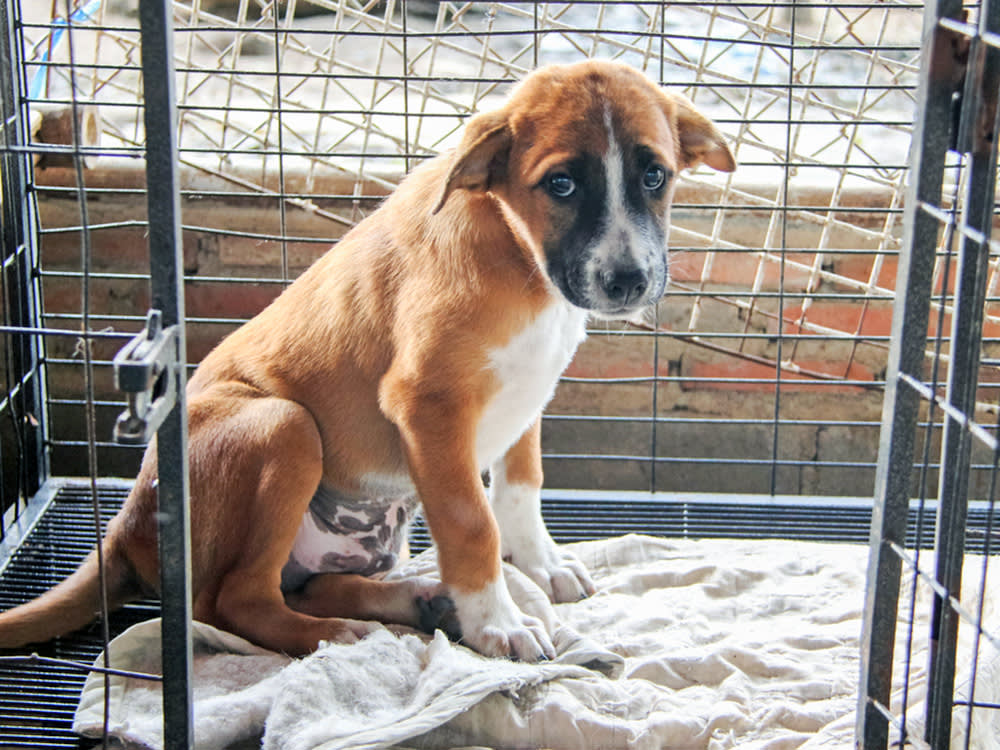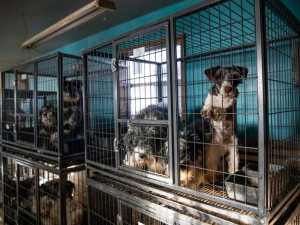Hundreds of USDA-Licensed Breeding Facilities Are Mistreating Dogs, New Report Finds
The ASPCA’s annual report has found that the USDA has failed to protect dogs from being bred in inhumane conditions.

Share Article
It’s reasonable to believe that a pet store or online platform that assures consumers it sells puppies bred from “United States Department of Agriculture (USDA)-licensed” breeders is, therefore, selling puppies born at responsible, humane facilities.
At least, it should be reasonable, but far too often, the label “USDA-licensed” doesn’t mean much at all in terms of its implications for the treatment of dogs in a licensed facility’s care. According to a recent American Society for the Prevention of Cruelty to Animals (ASPCA) reportopens in a new tab, hundreds of USDA-licensed and inspected facilities failed to provide humane conditions or basic care to the dogs that were then sold to the public.

Get (totally free) deals for food, treats, accessories, tech, and way more pet parenting must-haves.
opens in a new tabIn fact, according to the ASPCA’s report — a review of thousands of inspections and enforcement records of USDA-licensed dog dealers published by the USDA or obtained through Freedom of Information Act (FOIA) requests — USDA inspection reports detailed over 800 violations at USDA-licensed dog-breeding facilities across the country, accounting for one out of every five USDA inspections. And yet, only two dog dealers who violated the law lost their licenses, two paid fines, and not a single dog was removed from any facility.
In the United States, any individual or business that breeds, sells, exhibits, researches, or transports animals for profit is required to provide humane care, according to the Animal Welfare Actopens in a new tab (AWA), the only federal law that regulates animal welfare. This shouldn’t be too hard, considering that the standards required by the AWA are low.
“Some people call [the AWA’s standards] survival standards or minimal standards,” says Jennie Lintz, senior director of Puppy Mill Initiatives for the ASPCA. “Basically, the animal has to have water and food, and if they’re sick, they have to have vet care.”
How does the USDA monitor these standards?
The USDA is obligated to enforce this legislationopens in a new tab and does so through a system of licensing and inspection. The licensing processopens in a new tab is not arduous: It involves filling out a one-page application and paying a $120 fee. According to the ASPCA, 100 percent of commercial dog dealers who asked for a USDA license in 2024 got one.
Licensed facilities also agree to submit to three scheduled inspections, of which they only have to pass one. They also have to agree to unannounced inspections in the future. And yet, in 2024, less than one-third of the 17,500 USDA-licensed or registered commercial dog facilities overseen by the USDA had a compliance inspection, according to the ASPCA report. What’s more, more than 100 times in 2024, licensees turned the USDA away when subjected to an unannounced inspection, a violation that often goes uncorrected and unpunished.
Of those licensed facilities that were inspected, which housed over 200,000 dogs, one out of every five failed to comply with the basic standards laid out in the AWA. These violations, which the ASPCA reports the USDA itself documented, are horrific.
One breeder in Missouri (still, to this date, the biggest offender of puppy millsopens in a new tab in the U.S.) housed eight dogs outside in the blistering sun without shade. In addition, they kept a Boxer in a shelter too small for him to stand upright. On three separate occasions, the USDA recorded dogs dying from fighting with other dogs in a shared space at a New York breeder’s facility without any intervention from the breeders. After avoiding inspections for almost three years, the USDA documented that an Oklahoma breeder kept their dogs “in enclosures with holes, crumbling insulation, rusted walls, mud, pools of waste, pests, and feces.”
Other violations the USDA reported facilities that failed to provide their dogs with shelter, clean food or water, or veterinary care. These infractions also included dogs living in waste, with painful wounds and suffering from contagious and deadly diseases. In addition, there are reports of dogs who died in barn fires or from fights with other dogs or the cold. In some cases, there is no explanation listed at all.
How can the USDA fail animals like this?
Again, these are violations the USDA itself documented. In February the USDA’s Office of the Inspector General (OIG) published an internal audit opens in a new tabconfirming that the agency is failing to protect dogs in federally regulated commercial breeding facilities (also confirming the findings in the ASPCA’s report).
It’s clear that the USDA observed AWA violations and deplorable conditions in the facilities they licensed and did nothing, despite having the authority to do so. Not a single dog was removed from any USDA-licensed facilities, even those facilities egregiously violating the AWA and submitting their dogs to inhumane living conditions, in 2024.
What’s more, per the ASPCA, the USDA limits the number of observed animal welfare violations that show up on a licensee’s report, so even these documented AWA violations may not tell the full story of abuse happening in USDA-licensed facilities across the country.
“There’s somewhat of a conflict inherent in the fact that the Department of Agriculture licenses these facilities while, at the same time, their mission is to encourage agriculture,” Lintz says. “Fortunately or unfortunately, these animals are considered agriculture, and that’s why the USDA has oversight over them.”
Additionally, while the USDA does have the authority to revoke licenses, issue penalties, and remove animals, “their goal is not punishment; they’re not trying to catch people,” Lintz says. “Their goal is to get them to comply.”
What can we do about it?
While the OIG report has issued recommendations for the USDA, including ensuring inspection due dates are better adhered to and that they develop a process to better handle complaints, ultimately, as Lintz put it, “at some point, you need more than a recommendation; you need requirements” which, she notes, can only come from congressional action.
That action, the ASPCA believes, can take the form of Congress passing Goldie’s Actopens in a new tab, legislation that would require the USDA to take measures such as imposing meaningful penalties for violations, provide lifesaving intervention, and conduct better inspections of licensed facilities. People can contact their member of Congress via the ASPCAopens in a new tab to urge them to support the Act.
At the very least, Lintz says, anyone looking to buy a purebred puppyopens in a new tab (though adopting a rescue purebredopens in a new tab is always an option) should “work with a breeder in person, see that dog in person, see the facility in person” and avoid online retailers or pet stores. “We want the public to know that pet stores and internet sellers rely on USDA-licensed facilities because they’re the only kind that produce mass amounts of puppies on demand, as quickly as they do.”
Again, adopting a dogopens in a new tab from a reputable rescue organization or local shelter is the best way to avoid supporting breeders in general. Even among those who adhere to the AWA standards, according to Lintz, far too many are “far from what anybody would consider gold standard. Nobody I know who has an animal would want their dog to live in one of these facilities.”

Julie Zeilinger
Julie Zeilinger is a NYC-based writer and editor whose writing has been published in Marie Claire, Vox, HuffPost, Forbes, and other publications. She is also the author of two books: College 101: A Girl’s Guide to Freshman Yearopens in a new tab (2014) and A Little F’d Up: Why Feminism Is Not a Dirty Wordopens in a new tab (2012). She is the mom to Baloo, a two-year-old Bichpoo and foster mom to dogs via Badass Animal Rescueopens in a new tab.
Related articles
![The Horrible Hundred report is a list of problematic puppy breeding and/or puppy brokering facilities updated annually by the HSUS.]() opens in a new tab
opens in a new tabThe HSUS’s “Horrible Hundred” Exposes 100 Known Puppy Mills in the United States
The annual report raises awareness for animal cruelty and this inhumane practice.
![A woman with a dog on her lap sitting at a desk with a laptop.]() opens in a new tab
opens in a new tabWhat Happens After You Sign a Petition Anyway?
Three animal rights attorneys on what it takes to ban puppy mills and other ways to get involved in animal advocacy.
![Cruelty seizure at a suspected puppy mill in NC leaves scores of schnauzers and other dogs in desperate need.]() opens in a new tab
opens in a new tabOver 170 Dogs Were Rescued From a Suspected Puppy Mill in North Carolina
The pups are being rehabilitated after a massive, life-saving mission.
![A dog lying on a rug with a litter of puppies feeding from her.]() opens in a new tab
opens in a new tabWhy You Shouldn’t Adopt a Pet From Social Media or Buying/Selling Sites
It’s not quite the same as buying secondhand clothes…
![Woman hugs her black poodle dog outside in New York City.]() opens in a new tab
opens in a new tabNew York City Passed Legislation Banning the Sale of Dogs and Cats in Pet Stores
A handful of other cities and states have done the same in an effort to end the puppy mill pipeline.







